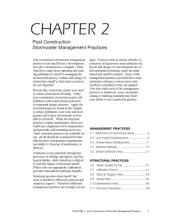
Stormwater runoff from impervious surfaces severely impacts Ohio ’s coastal communities and environments. It erodes streams, overloads drainage systems and water treatment facilities, increases flooding, impairs water quality, and degrades habitats. The severity of these impacts has increased with the number of heavy storms in Ohio, which are up 31 percent over the past 50 years. Traditional “pipe and pond ” approaches to stormwater management do not adequately prevent flooding or protect water quality. Fortunately, there are low-impact development (LID) alternatives that promote infiltration of rainwater where it falls, thereby reducing floods and promoting clean water. A 2011 Collaborative Research project led by the Old Woman Creek Reserve provided a much-needed local demonstration of different LID stormwater treatment techniques and promoted the use of these approaches throughout the state.
This document, developed by the project team, describes structural practices to treat runoff and management practices to prevent and minimize impacts from stormwater on post-construction development sites.